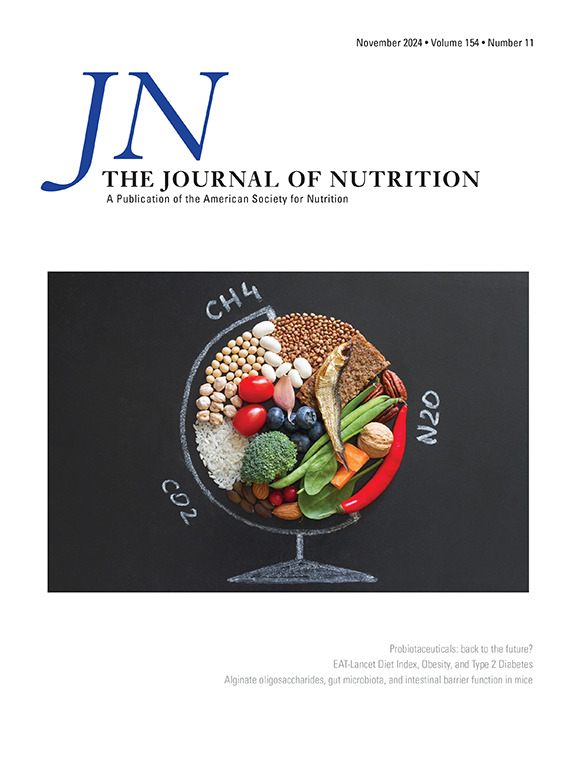Associations of Pregnancy Dietary Quality and Diversity with Childhood Celiac Disease
IF 3.8
3区 医学
Q2 NUTRITION & DIETETICS
引用次数: 0
Abstract
Background
High gluten and low dietary fiber in pregnancy intake is associated with an increased risk of celiac disease (CeD) in the child. Early life higher dietary quality is suggested to reduce the subsequent risk of CeD.
Objectives
The aim was to investigate associations of pregnancy dietary quality and diversity with child risk of CeD.
Methods
In The Norwegian Mother, Father and Child Cohort Study, 85,122 mother-child pairs had available data from a validated pregnancy food frequency questionnaire. Pregnancy dietary quality and diversity were estimated by a Pregnancy Healthy Eating Index [mean 99.3, standard deviation (SD) 9.9, range 48.8–128.3], and a Diet Diversity Score (mean 7.0, SD 1.0, range 1.6–9.8), respectively. Child CeD was captured by ≥2 diagnostic codes in the Norwegian Patient Registry. Logistic regression was used to estimate associations between pregnancy dietary quality, diversity and child CeD, adjusted for socioeconomic factors, and parents CeD [adjusted odds ratio (aOR), 95% confidence intervals (CI)]. CeD-susceptible human leukocyte antigen haplotypes (DQ2/DQ8) were present in 30,718 (45.5%).
Results
Up to mean age 16.0 (SD 1.8, 12.4–19.8) y, 1363 (1.6%) children were diagnosed with CeD. Lower as well as higher pregnancy dietary quality associated with a reduced risk of CeD in the child (<5th percentile aOR = 0.67, 95% CI: 0.48, 0.93, >95th percentile aOR = 0.71, 95% CI: 0.52, 0.98, respectively, nonlinear squared term P = 0.011). Analyses on genetically susceptible children, adjustments for pregnancy iron supplementation, gluten, and dietary fiber intake, and child early life dietary quality, gluten intake and iron supplementation, supported the finding. Pregnancy dietary diversity was not associated with child CeD (aOR = 1.00, 95% CI: 0.94, 1.07/score).
Conclusions
In this population-based study, lower as well as higher pregnancy dietary quality associated with a reduced risk of CeD diagnosis in the child. In contrast, no such association was observed with maternal dietary diversity.
孕期饮食质量和多样性与儿童乳糜泻的关系。
背景和目的:孕期摄入高麸质和低膳食纤维与儿童罹患乳糜泻的风险增加有关。有人认为,早期提高膳食质量可降低罹患乳糜泻的风险。本研究旨在调查孕期饮食质量和多样性与儿童乳糜泻(CeD)风险之间的关系:在挪威母亲、父亲和儿童队列研究(The Norwegian Mother, Father and Child Cohort Study)中,有85122对母子从有效的孕期食物频率问卷中获得了数据。孕期饮食质量和多样性分别通过孕期健康饮食指数(平均值99.3,标准差9.9,范围48.8-128.3)和饮食多样性评分(平均值7.0,标准差1.0,范围1.6-9.8)来估算。儿童CeD由挪威患者登记册中>2个诊断代码记录。采用逻辑回归法估算孕期膳食质量、多样性与儿童CeD之间的关系,并对社会经济因素和父母CeD进行调整(调整后的几率比[aOR],95%置信区间[CI])。30718人(45.5%)存在CeD易感HLA单倍型(DQ2/DQ8):平均年龄为 16.0(SD 1.8,12.4-19.8)岁的儿童中有 1363 人(1.6%)被诊断出患有 CeD。孕期饮食质量越低或越高,儿童患 CeD 的风险就越低(分别为第 1 百分位 aOR=0.67,95%CI 0.48-0.93,>第 95 百分位 aOR=0.71,95%CI 0.52-0.98,非线性平方项 p=0.011)。对遗传易感儿童进行分析,调整孕期铁补充剂、麸质和膳食纤维摄入量,以及儿童早期生活饮食质量、麸质摄入量和铁补充剂,均支持这一发现。孕期膳食多样性与儿童 CeD 无关(aOR=1.00,95%CI 0.94-1.07/分):在这项基于人群的研究中,孕期饮食质量越低和越高,儿童确诊 CeD 的风险就越低。与此相反,母体膳食多样性与CeD并无关联。
本文章由计算机程序翻译,如有差异,请以英文原文为准。
求助全文
约1分钟内获得全文
求助全文
来源期刊

Journal of Nutrition
医学-营养学
CiteScore
7.60
自引率
4.80%
发文量
260
审稿时长
39 days
期刊介绍:
The Journal of Nutrition (JN/J Nutr) publishes peer-reviewed original research papers covering all aspects of experimental nutrition in humans and other animal species; special articles such as reviews and biographies of prominent nutrition scientists; and issues, opinions, and commentaries on controversial issues in nutrition. Supplements are frequently published to provide extended discussion of topics of special interest.
 求助内容:
求助内容: 应助结果提醒方式:
应助结果提醒方式:


